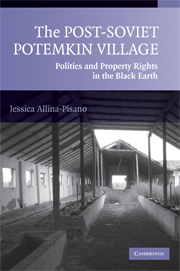Book contents
- Frontmatter
- Contents
- List of Maps, Illustrations, and Tables
- Acknowledgments
- Note on Transliteration
- Note on Sources and Methodology
- Glossary
- Two regions of the Black Earth, Voronezh and Kharkiv oblasti, 1991–present
- Voronezh oblast' in the twenty-first century
- Kharkiv oblast' in the twenty-first century
- The Post-Soviet Potemkin Village
- Introduction: Land Reform in Post-Communist Europe
- 1 Things Fall Apart
- 2 Keeping the Collectives
- 3 The Social Origins of Private Farmers
- 4 A Return to Regulation
- 5 The Politics of Payment
- 6 The Facade
- Conclusion: Rural Proletarians in the Potemkin Village
- Index
3 - The Social Origins of Private Farmers
Published online by Cambridge University Press: 27 July 2009
- Frontmatter
- Contents
- List of Maps, Illustrations, and Tables
- Acknowledgments
- Note on Transliteration
- Note on Sources and Methodology
- Glossary
- Two regions of the Black Earth, Voronezh and Kharkiv oblasti, 1991–present
- Voronezh oblast' in the twenty-first century
- Kharkiv oblast' in the twenty-first century
- The Post-Soviet Potemkin Village
- Introduction: Land Reform in Post-Communist Europe
- 1 Things Fall Apart
- 2 Keeping the Collectives
- 3 The Social Origins of Private Farmers
- 4 A Return to Regulation
- 5 The Politics of Payment
- 6 The Facade
- Conclusion: Rural Proletarians in the Potemkin Village
- Index
Summary
Even as local state officials and farm directors sought to “maintain the collectives, just in a different form,” reformers continued to envision the realization of a Jeffersonian dream in Eurasia. For advocates of land privatization, one path to modernization lay through the creation of yeoman farms. These farms would be similar to the family farms that, until the last decades of the twentieth century, had come to typify the North American landscape: small commercial agricultural companies managed by a single owner or group of owners.
Private farming, instituted as a successor policy to the leasing brigades of the late 1980s and modeled in part on the Stolypin-era reforms of the early twentieth century, emerged prior to the fall of the Soviet Union and continued, parallel with the reorganization of collective and state farms, in independent Ukraine and Russia. The modest scale and success of the private farming movement did not equal the attention it initially received from both policy makers in Moscow and Kyiv and foreign observers. In the countryside, local state officials did not appear to share the dream they were charged with bringing to fruition, and the new class of market-minded, efficient peasant producers that would provide food for the cities did not emerge the way reformers hoped it would.
During the 1990s, the Russian and Ukrainian governments issued multiple decrees and legislative acts to support the creation of private farms.
- Type
- Chapter
- Information
- The Post-Soviet Potemkin VillagePolitics and Property Rights in the Black Earth, pp. 85 - 112Publisher: Cambridge University PressPrint publication year: 2007



